| 1 |
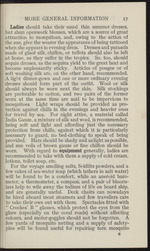 |
“...MORE GENERAL INFORMATION 17
Ladies should take their usual thin summer dresses,
but shun openwork blouses, which are a source of great
attraction to mosquitoes, and, owing to the action of
the sun, give the wearer the appearance of being tattooed
when she appears in evening dress. Dresses and parasols
made of glacé silk, chiffon, or taffeta should also be left
at home, as they suffer in the tropics. So, too, should
sequin dresses, as the sequins yield to the great heat and
become unpleasantly sticky. Articles of pongee or of
soft washing silk are, on the other hand, recommended.
A light dinner-gown and one or more ordinary evening
dresses should form part of the outfit. Wool or silk
should always be worn next the skin. Silk stockings
are preferable to cotton, and two pairs of the former
worn at the same time are said to be impervious to
mosquitoes. Light wraps should be provided as pro-
tection against chills in the evenings and heavier ones
for travel by sea. For night attire, a material...”
|
|
| 2 |
 |
“...Cathedral (to the right) and the Hamilton Hotel
((to the left). The Cathedral, which is dedicated to the
Holy Trinity, and has a seating capacity of 1,200, re-
places a building destroyed by fire in 1884. The chancel
was consecrated on May nth, 1911, by Bishop Jones.
The Cathedral is a handsome edifice built of native
limestone faced with Caen stone for the doors and win-
lows. The tower (144 feet high) is partly built of Nova
Icotia freestone. The total cost was about $200,000.
I The foundation-stone of the palatial Hamilton Hotel
jpas laid with full Masonic honours by Captain Charles
Elliott, R.N., the then Governor of Bermuda, in August,
^852, but the hotel was not opened until 1863. Since
Ihat year it has received many additions, and it may
Aow be considered one of the best hotels in this part
ffj the world. Opposite the hotel is the Mechanics’
Ball, built in 1850 to house the Bermuda Mechanics’
Beneficial Association. On the left-hand side of Queen
ftreet are the grounds of Par la Ville...”
|
|
| 3 |
 |
“...West India Cable Companies,
faces the square.
The Hotel St. George, opened in 1907, stands on the
Rose Hill property, once the residence of Governor
Tucker (1803-1805), about 100 feet above the town. It
commands a noble view of Castle Harbour, Castle Island,
and St. David’s. In front of the hotel are two trees
said to have been planted as sprigs from a bride’s
bouquet many years ago. Behind the old Government
House is the entrance to the Public Gardens, which
deserve a visit. In the wall on the left-hand side of the
entrance is a tablet to the memory of Sir George Somers.
It was erectéd at the instance of Governor Sir John H.
Lefroy, and is inscribed :
Near this spot
WAS INTERRED IN THE YEAR l6lO,
THE HEART OF THE HEROIC ADMIRAL
Sir George Somers, Kt.,
WHO NOBLY SACRIFICED HIS LIFE
TO CARRY SUCCOUR
TO THE INFANT AND SUFFERING PLANTATION
NOW
the State of Virginia.
To preserve his fame for future ages,
NEAR THE SCENE OF HIS MEMORABLE
SHIPWRECK, 1609,
the Governor and Commander-in-Chief
of this...”
|
|
| 4 |
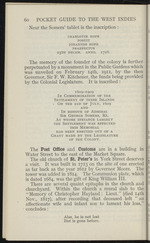 |
“...Street to the east of the Market Square.
The old church of St. Peter’s in York Street deserves
a visit. It was built in 1713 on the site of one erected
as far back as the year 1612 by Governor Moore. The
tower was added in 1814. The Communion plate, which
is dated 1684, was the gift of King William III.
There are several quaint epitaphs in the church and
churchyard. Within the church a mural slab to the
“Memory of Christopher Hayland : Lieut.” (died 14th
Nov., 1817), after recording that deceased left “ an
affectionate wife and infant son to lament his loss,”
concludes:
Alas, he is not lost
But is gone before....”
|
|
| 5 |
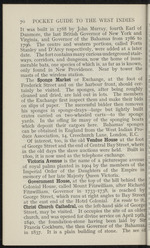 |
“...Victoria Avenue is the name of a picturesque avenue
of royal palms planted in 1904 by the members of the
Imperial Order of the Daughters of the Empire in
memory of her late Majesty Queen .Victoria. J
Government House, at the top of the hill behind the
Colonial House, called Mount Fitzwilliam, after Richard
Fitzwilliam, Governor in 1733-1738, is reached by
George Street, which runs at right angles to Bay Street
at the east end of the Hotel Colonial. En route to it,
Christ Church Cathedral, on the left-hand side of George
Street, may be visited. It occupies the site of an older
church, and was opened for diVine service on April 19th,
1840, the foundation-stone having been laid by Sir
Francis Cockbum, the then Governor of the Bahamas
in 1837. It is a plain building of stone. The see oi
I
r
I)
lb
r
u
I
lb
fc
C
k
|n
hi
ft
||
PJ
|e
ai
ni
B
11
h
b
il
#
it
!,oi
f
A
01
m
Ejp’
,w
[IB
jn
C(
12:
T...”
|
|
| 6 |
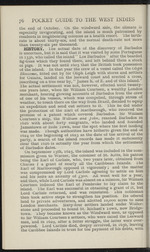 |
“...end of October. On the windward side, the climate is
especially invigorating, and the island is much patronised by
residents in neighbouring colonies as a health resort, ihe birth-
rate is about thirty-six, and the normal death-rate not more
than twenty-six per thousand.
HISTORY, ihe actual date of the discovery of Barbados
is uncertain, but it is said that it was visited by some Portuguese
in 1536, who called the island ‘' Los Barbudos'' after the bearded
fig-trees which they found there, and left behind them a stock
01 pigs, it was not until 1605 that the British took possession
of the island. In that year the crew of a vessel called the Ultph
Blossome, fitted out by Sir Oliph Leigh with stores and settlers
for Guiana, landed on the leeward coast and erected a cross,
inscribing on a tree near by,1 * J ames It. of E. and of this Island.
Ihe actual settlement was not, however, effected until twenty-
one years later, when Sir William Courteen, a wealthy London
merchant, hearing glowing accounts...”
|
|
| 7 |
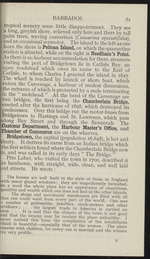 |
“...BARBADOS 81
Jtropical scenery some little disappointment. They see
!fa lon8< greyish shore, relieved only here and there by tall
palm trees, waving casuarinas {Casuarina equisetifolia)
Band an occasional aermotor. The island to the left as one
Baces the shore is Pelican Island, on which the quarantine
Istation is situated, while on the right is Needham’s Point.
Bps there is no harbour accommodation for them, steamers
Ivisiting the port of Bridgetown lie in Carlisle Bay, an
{open roadstead which owes its name to the Earl of
Carlisle, to whom Charles I granted the island in 1627.
r he wharf is reached by launch or shore boat, which
fenters the Careenage, a harbour of modest dimensions
phe entrance of which is protected by a mole terminating
m the molehead." At the bend of the Careenage are
[two bridges, the first being the Chamberlain Bridge,
erected after the hurricane of 1898, which destroyed its
predecessor. Over this bridge run the motor-buses from
Bridgetown to Hastings and St. Lawrence...”
|
|
| 8 |
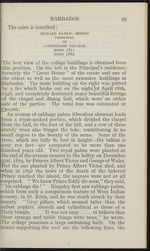 |
“...BARBADOS
95
The caim is inscribed:
RICHARD RAWLE---BISHOP
PRINCIPAL
OF
CODRINGTON COLLEGE
BORN l8ll
DIED 1889
The best view of the college buildings is obtained from
„this position. On the left is the Principal’s residence,
formerly the “ Great House ” of the estate and one of
the oldest as well as the most extensive buildings in
Barbados. The main building on the right was gutted
by a fire which broke out on the night [of April 18th,
1926, and completely destroyed many beautiful fittings
of the chapel and dining hall, which wereTon either
side of the portico. The total loss was estimated at
[f30,000.
j An avenue of cabbage palms (Oreodoxa oleracea) leads
from a triple-arched portico, which divided the chapel
from the hall, to the foot of the hill, and a row of these
stately trees also fringes the lake, contributing in no
small degree to the beauty of the scene. Some of the
trees, which are fully 80 feet in height—the tallest is
lover 100 feet—are computed to be more than one
ihundred years...”
|
|
| 9 |
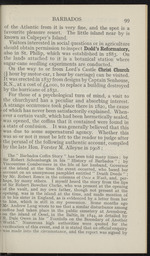 |
“...destroyed
by the hurricane of 1831.
For those of a psychological turn of mind, a visit to
the churchyard has a peculiar and absorbing interest.
A strange occurrence took place there in 1820, the cause
of which has never been satisfactorily explained. When-
ever a certain vault, which had been hermetically sealed,
was opened, the coffins that it contained were found in
a state of confusion. It was generally believed that this
was due to some supernatural agency. Whether this
was so or not it must be left to the reader to judge after
the perusal of the following authentic account, compiled
by the late Hon. Forster M. Alleyne in 1908 :
The Barbados Coffin Story ” has been told many times ; by
Sir Robert Schomburgk in his “ History of Barbados ” ; by
jViscountess Combermere in the life of her husband, Governor
of the island at the time the event occurred, who based her
account .on an anonymous pamphlet entitled " Death Deeds ” •
by Mr. Robert Reece in the columns of Once a Week, and, peri
haps, by...”
|
|
| 10 |
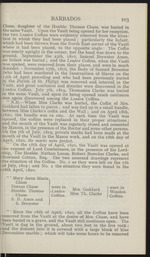 |
“...the presence of the Rector and some other persons.
[On the 7th of July, 1819, private marks had been made at the
mouth of the Vault in the Mason work, and on the 18th day of
(April, 1820, the marks were perfect.
I*. On the 18th day of April, 1820, the Vault was opened at
(the request of Lord Combermere, in the presence of his Lord-
ship, The Honble. Nathan Lucas, Robert Bowcher Clarke, and
[Rowland Cotton, Esq. The two annexed drawings represent
the situation of the Coffins. No. 1 as they were left on the 7th
of July, 1819 ; and No. 2 the situation they were found in the
18th April, 1820.
" ' Mary Anna Maria»
Chase
Dorcas Chase
Honble. Thomas
. Chase
S. B. Ames and
S. Brewster
were in
-Leaden
Coffins.
Mrs. Goddard
Miss Th. Clarke
were in
Wooden
Coffins.
I Since the 18th of April, 1820, all the Coffins have been
tremoved from the Vault at the desire of Mrs. Chase, and have
|been buried in a grave, and the Vault still continues open. The
I Vault is dug in the ground, about two, feet in the...”
|
|
| 11 |
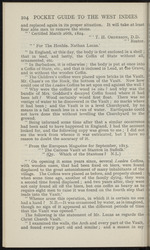 |
“...without all,
ornamented, etc.
“ In Barbadoes, it is otherwise ; the body is put at once into
a Coffin of State, etc., and that is inclosed in Lead, at fhe Grave,
and is without the wooden Coffin.
" The Children’s coffins were placed upon bricks in the Vault.
Mr. Chase’s on the Rock, the bottom of the Vault. Now how
could one of the Leaden Coffins be set upon end against the wall ?
“ Why were the coffins of wood in situ ? and why was the
bundle of Mrs. Goddard’s decayed Coffin found where it had
been left ? Wood certainly would first float. There was no
vestige of water to be discovered in the Vault; no marks where
it had been ; and the Vault is in a level Churchyard, by no
means in a fall much less in a run of water. Earthquake could
not have done this without levelling the Churchyard to the
ground.
“ Being informed some time after that a similar occurrence
had been said to have happened in England, I had the account
looked for, and the following copy was given to me ; I did not
see the work from...”
|
|
| 12 |
 |
“...3d. a journey, but any
passenger may transfer from one route to another without extra
charge, except in the case of the " Belt ” circuit, to which no
transfer is allowed.
A Government railway serves many parts of the island. Its
total length is 124J miles. One line runs through St. Joseph
and Arima to Sangre Grande, 8 miles from the east coast. It I
passes through some of the finest cocoa districts and affords
beautiful views of the central range of mountains (right) and
of the northern range (left).
St. Joseph is the junction for a line running south through
areas under sugar-cane to San Fernando and Siparia. From
Jerningham Junction on the San Fernando line a branch extends
in a south-easterly direction to Tabaquite and Rio Claro.
Two lines reach Princes’ Town ; one from Marabella Junction,
2 miles north of San Fernando, and the other from San Fernando,
itself. For distances and fares, see table on the opposite page.
Steamers run from Port of Spain to San Fernando and also,
in connection...”
|
|
| 13 |
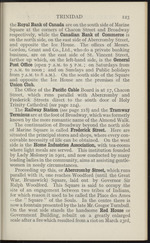 |
“...TRINIDAD
123
the Royal Bank of Canada are on the south side of Marine
I Square at the comers of Chacon Street and Broadway
i respectively, while the Canadian Bank of Commerce is
on the north side, on the east side of Abercromby Street,
and opposite the Ice House. The offices of Messrs.
I Gordon, Grant and Co., Ltd., who do a private banking
business, are on the east side of St. Vincent Street,
farther up which, on the left-hand side, is the General
Post Office (open 7 a.m. to 5 p.m. ; on Saturdays from
7 a.m. to noon; and on Sundays and Public holidays
from 7 a.m. to 8 a.m.). On the south side of the Square
and opposite the Ice House are the premises of the
Union Club.
The Office of the Pacific Cable Board is at 17, Chacon
Street, which runs parallel with Abercromby and
Frederick Streets direct to the south door of Holy
Trinity Cathedral (see page 124).
The Railway Station {see page 118) and the Tramway
Terminus are at the foot of Broadway, which was formerly
known by the more romantic...”
|
|
| 14 |
 |
“...examples of West Indian workmanship.
The marble reredos was erected by public subscription as
a memorial to Bishop Hayes (1889-1904) and was dedi-
cated in 1911. A chiming apparatus, the gift of Bishop
Rawle, is attached to the peal of eight bells.
The second turning to the right from Frederick Street
beyond Woodford Square leads past the local Y.M.C.A.
headquarters in Park Street, which was opened by
Governor Sir Samuel Wilson in 1922. Proceeding again
up Frederick Street, the first turning to the left (Oxford
Street) takes one to Harris Square, in which there is a
statue of Lord Harris, Governor from 1846 to 1854.
Passing St. Mary’s College, and the local Gaol, the next
turning on the right (Gordon Street) leads to Charlotte
Street, in which is the Colonial Hospital, that occupies
a handsome block of buildings standing in spacious
grounds, a feature of which are the tall royal palms.
The Government Laboratory, which replaces a building
dating from 1872, and destroyed by fire in 1896, is the...”
|
|
| 15 |
 |
“...the improvement
of live-stock, including horses, cattle, pigs, and poultry. I
Just beyond the Experiment Station and near the I
tramway terminus, Lady Chancellor’s Road, so named I
after the wife of Sir John Chancellor, Governor from I
1916 to 1921, runs to the heights of St. Ann’s for a I
distance of about two miles, affording splendid panoramic I
views of Port of Spain, the Gulf of Paria and away over I
the Caroni Swamp to San Fernando Hill which forms a 1
conspicuous object in the distance (left). The road I
was constructed by prison labour between 1916 and 1921, I
and it was hoped that sites would be taken up alongside I
it for building purposes; but this has not yet been done. 1
The road forms the north-west boundary of the famous I
Botanic Gardens, which adjoin Government House under I
the bills on the north side of the Savannah.
Government House stands at the foot of the hills at St: I
Ann's on the north or far side of the Savannah, which it I
overlooks. It is a substantial building...”
|
|
| 16 |
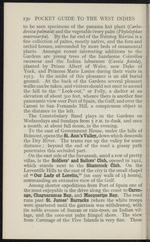 |
“...Wales, now Duke of I
York, and Princess Marie Louise during their, visits in I
1913. In the midst of this pleasance is an old burial I
ground. At the back of the Gardens several pleasant I
walks can be taken, and visitors should not omit to ascend I
the hill to the “ Look-out,” or Folly, a shelter at an I
elevation of about 300 feet, whence there is another fine I
panoramic view over Port of Spain, the Gulf, and over the I
Caroni to San Fernando Hill, a conspicuous object in I
the distance to the left.
The Constabulary Band plays in the Gardens on I
Wednesdays and Sundays from 5 p.m. to dusk, and once I
a month, at about full moon, in the evening.
To the east of Government House, under the hills of I
Belmont, opens the St. Ann’s Valley, down which descends I
the Dry River. The trams run up the valley for some I
distance; beyond the end of the road a grassy path I
penetrates this secluded part.
On the east side of the Savannah, amid a row of pretty I
villas, is the Soldiers’ and Sailors’ Clnb...”
|
|
| 17 |
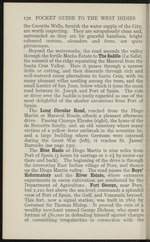 |
“...between St. Joseph and Port of Spain. The ride
or drive over the Saddle is justly regarded as one of the
most delightful of the shorter excursions from Port of
Spain.
The Long Circular Road, reached from the Diego
Martin or Maraval Roads, affords a pleasant afternoon
drive. Passing Champs Elysées (right), the home of the
de Boissière family, and an old cemetery where many
victims of a yellow fever outbreak in the seventies lie,
and a large building where Germans were interned
during the Great War (left), it reaches St. James’
Barracks (see page 130).
The Blue Basin at Diego Martin is nine miles from
Port of Spain (3 hours by carriage or i-i| by motor-car
there and back). The beginning of the drive is through
the interesting East Indian village of Peru, and thence
up the Diego Martin valley. The road passes the Boys’
Reformatory and the River Estate, where extensive
experiments in cocoa cultivation are conducted by the
Department of Agriculture. Fort George, near Peru,
but 1,120 feet above the...”
|
|
| 18 |
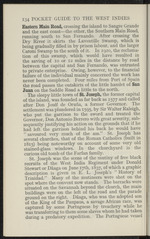 |
“...the garrison to the sword and treated the
Governor, Don Antonio Berrero with great severity, sub-
sequently justifying his action on the grounds that if he
had left the garrison behind his back he would have
“ savoured very much of the ass.” St. Joseph has
several churches, that of the Roman Catholics (built in
1815) being noteworthy on account of some very old
stained-glass windows. In the churchyard is the
curious old tomb of the Farfan family.
St. Joseph was the scene of the mutiny of free black
recruits of the West India Regiment under Donald
Stewart or Daaga on June 17th, 1837, of which a graphic
description is given in E. L. Joseph’s “ History of
Trinidad.” Many of the mutineers were shot on the
spot where the convent now stands. The barracks were
situated on the Savannah beyond the church, the main
buildings were on the left of the road and the parade
ground on the right. Daaga, who was the adopted son
of the King of the Paupaus, a savage African race, was
captured by some Portuguese...”
|
|
| 19 |
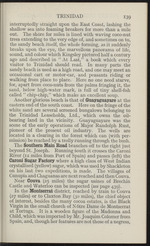 |
“...bungalows belonging to
the Trinidad Leaseholds, Ltd., which owns the oil-
bearing land in the vicinity. Guayaguayare was the
scene of the early operations of Major Randolph Rust,
pioneer of the present oil industry. The wells are
located in a clearing in the forest which can (with per-
mission) be reached by a trolly running through the bush.
The Southern Main Road branches off to the right just
beyond St. Joseph. Running éouth it crosses the Caroni
River (12 miles from Port of Spain) and passes (left) the
Caroni Sugar Factory where a high class of West Indian
crystallised (yellow) sugar, which was used by Shackleton
on his last two expeditions, is made. The villages of
Cunupia and Chaguanas are next reached and then Couva.
Near Couva (25 miles) the sugar usines of Brechin
Castle and Waterloo can be inspected (see page 439).
In the Montserrat district, reached by train to Couva
(27 miles) or to Claxton Bay (30 miles), the chief object
of interest, besides the many cocoa estates, is the Black...”
|
|
| 20 |
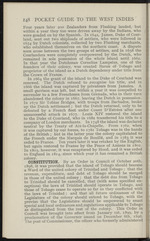 |
“...completely overpowered by the Dutch, who
remained in sole possession of the whole island until 1662.
In that year the Dutchman Cornelius Lampsius, one of the
founders of their colony, was created Baron df Tobago and
proprietor of the island as a Dutch dependency under title from
the Crown of France.
In 1664 the grant of the island to the Duke of Co'urland was
renewed. The Dutch refused to recognise his title, and in.
1666 the island was captured by privateers from Jamaica. A
small garrison was left, but within a year it was compelled to
surrender to a few Frenchmen from Grenada, who in their turn
abandoned the colony in 1667, leaving the Dutch in possession.
In 1672 Sir Tobias Bridges, with troops from Barbados, broke
up the Dutch settlement; but the Dutch returned, only to be
defeated by a French fleet under Count D’Estrées after one
unsuccessful attack in 1677. Louis XIV restored the island
to the Duke of Courland, who in 1682 transferred his title to a
company of London merchants. In...”
|
|
